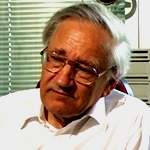-
Videos
- Video Interviews with Scientists
- Nobel Prize Video Interviews
- Issues of Concern
- Science Video Lectures
- Reflections on Science Videos
- Masterclass Science Videos
- Science Career Videos
- Lindau 2003 Documentary
- The Next Big Thing Science Videos
- Science Video Research Projects
- Educational Resources
- Documentaries
- Art & Science Videos
- STFC Video Portal
- Women in Science
- You are here >
- Home
- Programmes
- Video Interviews with Scientists
- Richard Ernst
In this video scientist and Nobel Laureate Richard Ernst is interviewed by Nobel Laureate Harry Kroto and ex BBC Horizon producer Edward Goldwyn. Recorded 2003-2004.
Nuclear magnetic resonance (nmr), a powerful technique for determining molecular structure, has totally revolutionised chemistry. From its inception half a century ago, its potential as an analytical tool for identifying compounds was clear, albeit limited by the fact that nmr is an intrinsically weak effect, requiring the most sensitive technology.
Richard Ernst is the scientist who, more than anyone else, has shown how this weakness can be overcome, and in so doing has transformed the technique into arguably the most powerful tool that chemists now have at their disposal for structural analysis. The key breakthroughs were achieved by successfully developing a whole range of ingenious approaches - including powerful so-called "2-dimensional nmr" strategies.
In this video we are taken on a highly personal tour of Richard`s life from childhood when he crawled around in his private world, the attic of the old house in which he was brought up and where he discovered and old box of chemicals, to the development of his exceptional ability to make the most complex state-of-the-art experimental equipment work.
We are also treated to a delightfully informative illustrated introduction to his major non-scientific passion, Tibetan Art, a subject on which Richard has become a leading expert. Last but not least we learn that Richard is also passionate about important issues that involve the responsibility of scientists in society.
We are most grateful to the COGITO Foundation for funding the production of the remarkable programme
Links To Other Information:








